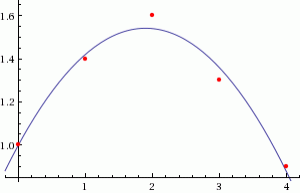Regresión no lineal en C#
Estoy buscando una manera de producir una curva no lineal (preferiblemente cuadrática), basada en un conjunto de datos 2D, con fines predictivos. Ahora mismo estoy usando mi propia implementación de mínimos cuadrados ordinarios (OLS) para producir una tendencia lineal, pero mis tendencias son mucho más adecuadas para un modelo de curva. Los datos que estoy analizando son la carga del sistema a lo largo del tiempo.
Aquí está la ecuación que estoy usando para producir mis coeficientes lineales:

He echado un vistazo a Math.NET Numerics y algunos otros libs, pero proporcionan interpolación en lugar de regresión (que no me sirve de nada), o el código simplemente no funciona de alguna manera.
¿Alguien sabe de alguna libs de código abierto libre o muestras de código que puedan producir los coeficientes para tal curva?
4 answers
Usé el MathNet.Iridium lanzamiento porque es compatible con.NET 3.5 y VS2008. El método se basa en la matriz Vandermonde. Luego creé una clase para mantener mi regresión polinómica
using MathNet.Numerics.LinearAlgebra;
public class PolynomialRegression
{
Vector x_data, y_data, coef;
int order;
public PolynomialRegression(Vector x_data, Vector y_data, int order)
{
if (x_data.Length != y_data.Length)
{
throw new IndexOutOfRangeException();
}
this.x_data = x_data;
this.y_data = y_data;
this.order = order;
int N = x_data.Length;
Matrix A = new Matrix(N, order + 1);
for (int i = 0; i < N; i++)
{
A.SetRowVector( VandermondeRow(x_data[i]) , i);
}
// Least Squares of |y=A(x)*c|
// tr(A)*y = tr(A)*A*c
// inv(tr(A)*A)*tr(A)*y = c
Matrix At = Matrix.Transpose(A);
Matrix y2 = new Matrix(y_data, N);
coef = (At * A).Solve(At * y2).GetColumnVector(0);
}
Vector VandermondeRow(double x)
{
double[] row = new double[order + 1];
for (int i = 0; i <= order; i++)
{
row[i] = Math.Pow(x, i);
}
return new Vector(row);
}
public double Fit(double x)
{
return Vector.ScalarProduct( VandermondeRow(x) , coef);
}
public int Order { get { return order; } }
public Vector Coefficients { get { return coef; } }
public Vector XData { get { return x_data; } }
public Vector YData { get { return y_data; } }
}
Que luego lo uso así: {[13]]}
using MathNet.Numerics.LinearAlgebra;
class Program
{
static void Main(string[] args)
{
Vector x_data = new Vector(new double[] { 0, 1, 2, 3, 4 });
Vector y_data = new Vector(new double[] { 1.0, 1.4, 1.6, 1.3, 0.9 });
var poly = new PolynomialRegression(x_data, y_data, 2);
Console.WriteLine("{0,6}{1,9}", "x", "y");
for (int i = 0; i < 10; i++)
{
double x = (i * 0.5);
double y = poly.Fit(x);
Console.WriteLine("{0,6:F2}{1,9:F4}", x, y);
}
}
}
Coeficientes calculados de [1,0.57,-0.15] con la salida:
x y
0.00 1.0000
0.50 1.2475
1.00 1.4200
1.50 1.5175
2.00 1.5400
2.50 1.4875
3.00 1.3600
3.50 1.1575
4.00 0.8800
4.50 0.5275
Que coincide con los cuadráticos resultados de Wolfram Alpha.


Editar 1
Para llegar al ajuste que quieres pruebe la siguiente inicialización para x_data y y_data:
Matrix points = new Matrix( new double[,] { { 1, 82.96 },
{ 2, 86.23 }, { 3, 87.09 }, { 4, 84.28 },
{ 5, 83.69 }, { 6, 89.18 }, { 7, 85.71 },
{ 8, 85.05 }, { 9, 85.58 }, { 10, 86.95 },
{ 11, 87.95 }, { 12, 89.44 }, { 13, 93.47 } } );
Vector x_data = points.GetColumnVector(0);
Vector y_data = points.GetColumnVector(1);
Que produce los siguientes coeficientes (de menor potencia a mayor)
Coef=[85.892,-0.5542,0.074990]
x y
0.00 85.8920
1.00 85.4127
2.00 85.0835
3.00 84.9043
4.00 84.8750
5.00 84.9957
6.00 85.2664
7.00 85.6871
8.00 86.2577
9.00 86.9783
10.00 87.8490
11.00 88.8695
12.00 90.0401
13.00 91.3607
14.00 92.8312
Warning: date(): Invalid date.timezone value 'Europe/Kyiv', we selected the timezone 'UTC' for now. in /var/www/agent_stack/data/www/ajaxhispano.com/template/agent.layouts/content.php on line 61
2011-11-04 14:50:29
El código@ja72 es bastante bueno. Pero lo porté en la versión actual de Math.NET (MathNet.Iridium no es compatible ahora, según tengo entendido) y optimizar tanto el tamaño del código como el rendimiento (Matemáticas.Función Pow no está utilizando en mi soltution debido a un rendimiento lento).
public class PolynomialRegression
{
private int _order;
private Vector<double> _coefs;
public PolynomialRegression(DenseVector xData, DenseVector yData, int order)
{
_order = order;
int n = xData.Count;
var vandMatrix = new DenseMatrix(xData.Count, order + 1);
for (int i = 0; i < n; i++)
vandMatrix.SetRow(i, VandermondeRow(xData[i]));
// var vandMatrixT = vandMatrix.Transpose();
// 1 variant:
//_coefs = (vandMatrixT * vandMatrix).Inverse() * vandMatrixT * yData;
// 2 variant:
//_coefs = (vandMatrixT * vandMatrix).LU().Solve(vandMatrixT * yData);
// 3 variant (most fast I think. Possible LU decomposion also can be replaced with one triangular matrix):
_coefs = vandMatrix.TransposeThisAndMultiply(vandMatrix).LU().Solve(TransposeAndMult(vandMatrix, yData));
}
private Vector<double> VandermondeRow(double x)
{
double[] result = new double[_order + 1];
double mult = 1;
for (int i = 0; i <= _order; i++)
{
result[i] = mult;
mult *= x;
}
return new DenseVector(result);
}
private static DenseVector TransposeAndMult(Matrix m, Vector v)
{
var result = new DenseVector(m.ColumnCount);
for (int j = 0; j < m.RowCount; j++)
for (int i = 0; i < m.ColumnCount; i++)
result[i] += m[j, i] * v[j];
return result;
}
public double Calculate(double x)
{
return VandermondeRow(x) * _coefs;
}
}
También está disponible en github:gist.
Warning: date(): Invalid date.timezone value 'Europe/Kyiv', we selected the timezone 'UTC' for now. in /var/www/agent_stack/data/www/ajaxhispano.com/template/agent.layouts/content.php on line 61
2015-07-22 11:50:22
No creo que quieras regresión no lineal. Incluso si está utilizando una función cuadrática, todavía se llama regresión lineal. Lo que quieres se llama regresión multivariante. Si quieres una cuadrática sólo tienes que añadir un término cuadrado de x a sus variables dependientes.
Warning: date(): Invalid date.timezone value 'Europe/Kyiv', we selected the timezone 'UTC' for now. in /var/www/agent_stack/data/www/ajaxhispano.com/template/agent.layouts/content.php on line 61
2011-11-04 00:01:31
Echaría un vistazo a http://mathforum.org/library/drmath/view/53796.html para intentar tener una idea de cómo se puede hacer.
Entonces este tiene una buena implementación que creo que le ayudará.
Warning: date(): Invalid date.timezone value 'Europe/Kyiv', we selected the timezone 'UTC' for now. in /var/www/agent_stack/data/www/ajaxhispano.com/template/agent.layouts/content.php on line 61
2011-10-17 10:20:31